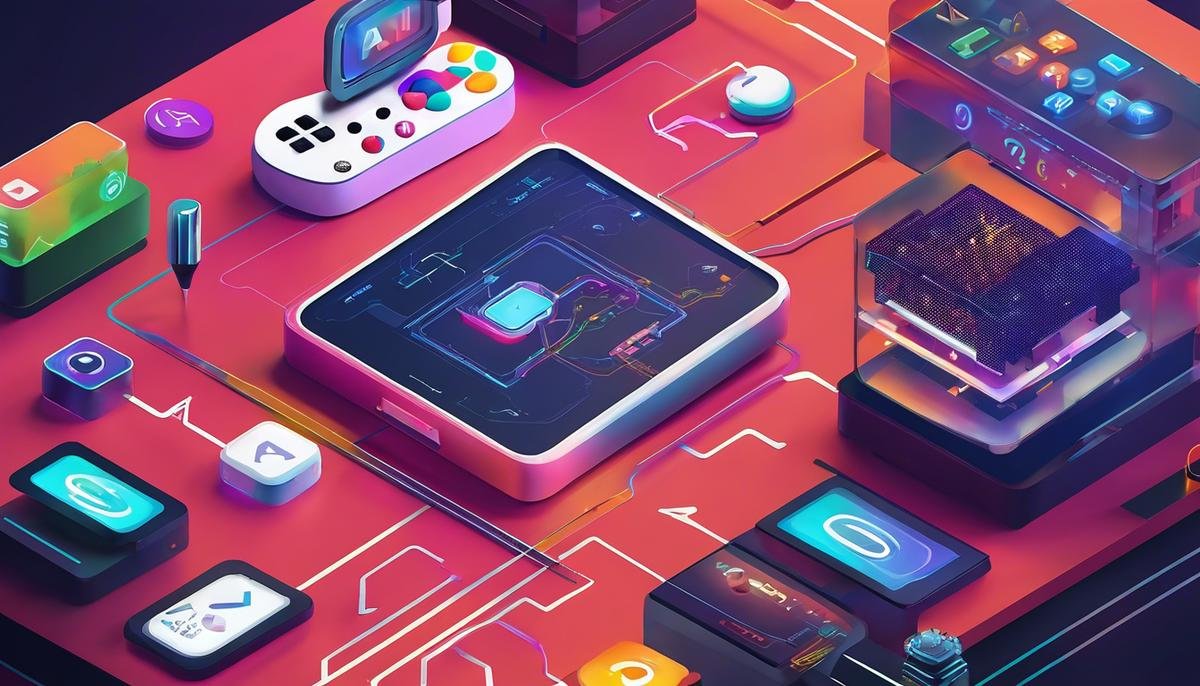As fast as technology evolves, so too does the world of gaming. Artificial Intelligence (AI) represents a forefront of this rapid progress, radically altering the gaming experience and moving it light years beyond Pong and Pacman. From enhancing Non-Player Character (NPC) interactions, enabling dynamic game worlds, and personalising experiences to the preferences of each individual player, AI’s integration into the gaming industry has been transformative. This extensive and insightful overview will take you on a journey to explore AI’s significant milestones throughout gaming history, its impact on game design, its role in enriching player experiences, and the exciting prospects for the future.
The Evolution of AI in Gaming
The Evolution of AI in Gaming: A Look at Key Milestones
AI has revolutionized the gaming industry in a way few could have predicted. From simplistic algorithms of early arcade games to intricate behaviors of characters in recent blockbusters, let’s explore the journey of AI in gaming and its noteworthy milestones.
Starting off the timeline, the 1950s and 60s brought the first instances of AI in gaming. Algorithms were used to mimic basic strategies, like in draughts, or follow a routine in games like “Pong”. The AI was rudimentary – straightforward, predictable. Yet, it laid the groundwork for the future.
The next key milestone in the 90s was the role of AI in first-person shooter games, exemplified by “Doom”. There was a shift towards responsive and intelligent game characters. The enemies could now sense, react to, and follow the player. It was a major leap, signaling the potential of AI in gaming to create more engaging and challenging experiences.
In the 2000s, the evolution of AI took another significant turn. Games like “The Sims” introduced a more complex AI. Characters led their own lives, independent of player interactions. The dynamic world of “Grand Theft Auto”, where AI-controlled characters behaved realistically to context, really pushed the envelope.
But the revolutionary period came in the 2010s. Games started employing machine learning algorithms. Now, AI could learn and adapt throughout the game, making them unpredictable and more life-like. Think “Alien: Isolation”, where the alien learns from its encounters with the player, leading to tense and dynamic gameplay. This marked a major turning point in the use of AI.
And now, 2020s wave of advancement in AI sees a focus on neural network-based AI. It’s no longer just about enhancing the gaming experience but also contributing to its development. An exciting prospect is AI’s role in procedurally generated content, where game worlds can be generated automatically in “Minecraft”. Tools like Promethean AI are helping developers create game artwork by understanding and learning from their previous artistic choices.
Looking forward, the use of AI in gaming will only intensify. AI opponents are getting harder to distinguish from human players. Games are becoming more immersive, dynamic, and personal. Even the line between player and creator is blurring, as everyone can have a say in shaping the in-game universe.
The evolution of AI in gaming is a perfect example of how technology can transform an industry. It’s about endlessly chasing a horizon, making the impossible, possible, and the game, a reality. For tech enthusiasts, it’s an exhilarating journey to follow and partake in.

The Impact of AI on Game Design
With this solid foundation of AI’s past and possible future, let’s dive deeper into a crucial question – how exactly does artificial intelligence shape and influence the design of games we love today?
Stitching together the programming ropes, we find AI acting in various influential roles.
First, AI plays a critical part in providing a consistent and conceivable world for gamers. It aids in environmental design, conducting automated testing to yield an immersive gaming space, instilling life and authenticity into the environment. This “under the hood” job might not gain the limelight, but from beautiful landscapes to unpredictable climatic conditions, AI is continually defining game settings.
Secondly, we find AI at the heart of physics engines, bringing about realistic interactions between player-controlled characters and the game world. The seamlessly interactive puddles in “Control,” the material-based destruction in “Red Faction,” or the hair and cloth movements in “Horizon Zero Dawn” – these are all glittering results of AI at work. AI ensures a tangible, responsive game world, driving an immersive gaming experience.
Thirdly, AI is pivotal in crafting non-player characters (NPCs) who behave convincingly and responsively. The highway robbers in “Skyrim” who plan an ambush, the xenomorph in “Alien: Isolation” stalking the player, or the wildlife in “Red Dead Redemption 2” scampering away at your approach – AI fuels their realism. It empowers game designers to offer a richer, more unpredictable game environment, thus enhancing replayability.
Furthermore, AI in game design extends beyond the usual action-battle scenarios, enabling the creation of complex, nuanced narratives. “Detroit: Become Human” weaves different storylines for characters based on player choices, pushing the boundaries of interactive storytelling. Likewise, “The Witcher 3” brings moral ambiguity into decisions, adding emotional depth to gameplay. These dynamic, emergent narratives represent a significant draw in today’s narrative-driven games, made possible by AI.
A more subtle yet compelling role of AI comes in its ability to adapt game difficulty according to player skill levels. Called dynamic difficulty adjustment (DDA), this allows both veterans and novices to enjoy the same game while provided with appropriate challenges. The shadowy Nemesis in “Resident Evil 3 Remake” can memorize player actions, adapt its strategy, and strike when least expected, offering a tailored horror experience for each player.
Lastly, AI continues to push the gaming envelope by creating designer-like content. Popularly known as generative AI, it’s seen in the procedurally generated dungeons of “No Man’s Sky” or the unique puzzle designs in “Baba Is You”. Given enough data, these algorithms can create fresh, unpredictable content, offering infinite play possibilities.
To conclude, AI stands as a major force of innovation and evolution in game design. Advancing from dice-rolling computer opponents to complex, learning adversaries, and NPCs, AI’s journey in gaming thus far has been one of fascination and awe. Yet, even now, it feels like we’re just scratching the surface of what lies ahead. AI’s role in mind-bending, heart-pounding gaming experiences promises an even more enthralling future, redefining what’s possible in the realm of virtual worlds.

AI in Player Experiences
Catalyzing Immersive Player Experiences: AI’s Crucial Role
The influence of Artificial Intelligence (AI) extends well beyond mundane tasks and hefty calculations. Today, AI plays a pivotal role in shaping immersive gaming experiences that are both effortless and engaging for players. This ingenious intersection of AI and gaming dramatically influences how players engage with their virtual landscapes.
AI for Consistent and Immersive Environment
A key role of AI is its ability to shape a realistic and consistently immersive gaming environment. The heart of the gaming experience lies not only in the plot, but also in the believability of the gaming world. Using AI, developers can sculpt lifelike elements into the environment that react rationally and coherently to player input, keeping them engrossed and invested.
AI and Authentic Physics in Gaming
Another commendable contribution of AI lies in mimicking real-world physics within games. The intricacies of physics known to us, like gravity, motion, and collision, are simulated using AI’s exceptional computational abilities, giving rise to authentic physics interactions. This makes gameplay scenarios even more riveting and convincing.
AI in Crafting Non-Player Characters (NPCs)
In the labyrinth of gaming, NPCs play an instrumental role. Traditionally, these characters functioned based on pre-determined paths or routines. Now, with AI, NPCs are engineered into smarter, more responsive entities that adapt and respond like genuine human players. This responsiveness amplifies the overall realism of the game, enriching the player’s experience.
AI and Complex Narratives
AI methods such as natural language processing (NLP) are essential to crafting complex and nuanced narratives in games. By implementing AI, storylines interactively adapt based on the actions or decisions players make throughout the game, making each play, each decision, consequential and unique.
Adapting Difficulty Levels with AI
Customizing the difficulty level of a game based on player skill is another fascinating area where AI plays a vital role. Through adaptive difficulty adjustment, AI monitors the player’s performance and tactically modifies the game difficulty. This ensures the game remains challenging enough to keep the player engaged, yet not get overly frustrating.
Role of AI in Generating Designer-like Content
AI’s capacity extends to creating designer-like content through generative algorithms. These algorithms fabricate everything from architectural structures to environmental elements, producing a continually refreshed and engaging gaming experience.
AI’s profound impact on game design is just the commercial edge of a technological iceberg. As AI continues to develop, it promises to offer more startling innovations that will redefine the gaming industry. Basking in the boundless potential of AI, we eagerly anticipate what future developments await on the horizon. No summary is needed for this adventure; we’re already in the thick of it. The game is on!

Future Prospects of AI in Gaming
In the great playground of technology, Artificial Intelligence (AI) shines as an incredibly transformative force. Gaming, in particular, wildly absorbs the innovations of AI. With the field maturing at a rapid pace, let’s take a look at where we might be heading in terms of AI in gaming.
With the advent of more advanced AI, an exciting potential arises for dynamic game worlds. By that, it means the creation of gaming environments that alter and evolve in response to player actions, essentially tailoring the experience on the fly. In a manner of speaking, these dynamic game worlds could offer a fresh experience each time a player dives into the realm – an idea that turns traditional gaming on its head!
Further advents in AI promise the amplification of immersive experiences. Photorealistic graphics and enhanced sound effects can only go so far in making a game world feel ‘alive’. What if AI could simulate a living, breathing ecosystem right within the game? Populating gaming environments with AI-powered biosystems – think weather patterns, wildlife behavior, the ebb and flow of in-game economy – could be the next big stride in immersion.
Games often employ AI to control Non-Player Character (NPC) behavior. With advances in AI, the expectation from NPCs has significantly risen. Gone are days when brain-dead enemies or redundant friendly NPCs were tolerated. Gamers want characters that offer challenging play, can devise strategies, display complex behavior, and respond realistically to their actions. With AI technologies like neural networks and machine learning, game developers might soon deliver NPC characters that are indistinguishable from human-controlled ones.
Another exciting possibility lies in utilizing AI for storytelling in games. Currently, game narratives are mostly linear or branching. However, the fusion of AI and procedural content generation could lead to dynamic storytelling. The narratives, individual character arcs, and dialogues could change based on player choices, making each playthrough a unique narrative experience, paving the way for an entirely new realm of interactive storytelling.
The potential of AI in generating custom content can’t be understated. The blend of AI and gaming can lead to personalized content generation. Imagine a game that generates player-specific quests based on playing habits or introduces unique game mechanics that adapt to a player’s style. It would transform the ‘one size fits all’ game design approach to something far more personalized and engaging.
Finally, consider the potential impact AI might have on game design itself. AI could become a powerful tool in the arsenal of game designers, helping to automate tedious tasks while unlocking new creative avenues. Designers could use advanced AI to create nuanced, convincing game worlds and compelling narratives, and even optimize game features based on player feedback swiftly processed by AI.
In conclusion, the intersection of AI and video games promises a fascinating journey ahead. Stakeholders are keenly watching developments in AI technology, eager to harness its potential to offer boundary-pushing gaming experiences. If video games are a form of escape, AI has the potential to make that escape extraordinarily enthralling!

As we stand on the precipice of new technological discoveries, the implementation of AI in gaming is an intriguing realm to watch. Its transformative impact on game design, its potential to revolutionize player experiences and its predicted influence on the future of the gaming industry are shaping up to be game-changers. The continuous adaptations and technological leaps in AI promise even more immersive, challenging, and personalized gaming experiences. So whether you’re a player on the quest for an unparalleled adventure, or a game developer striving to create the most realistic virtual universe, the role of AI in gaming marks the beginning of an exciting new chapter in human-tech interaction.



